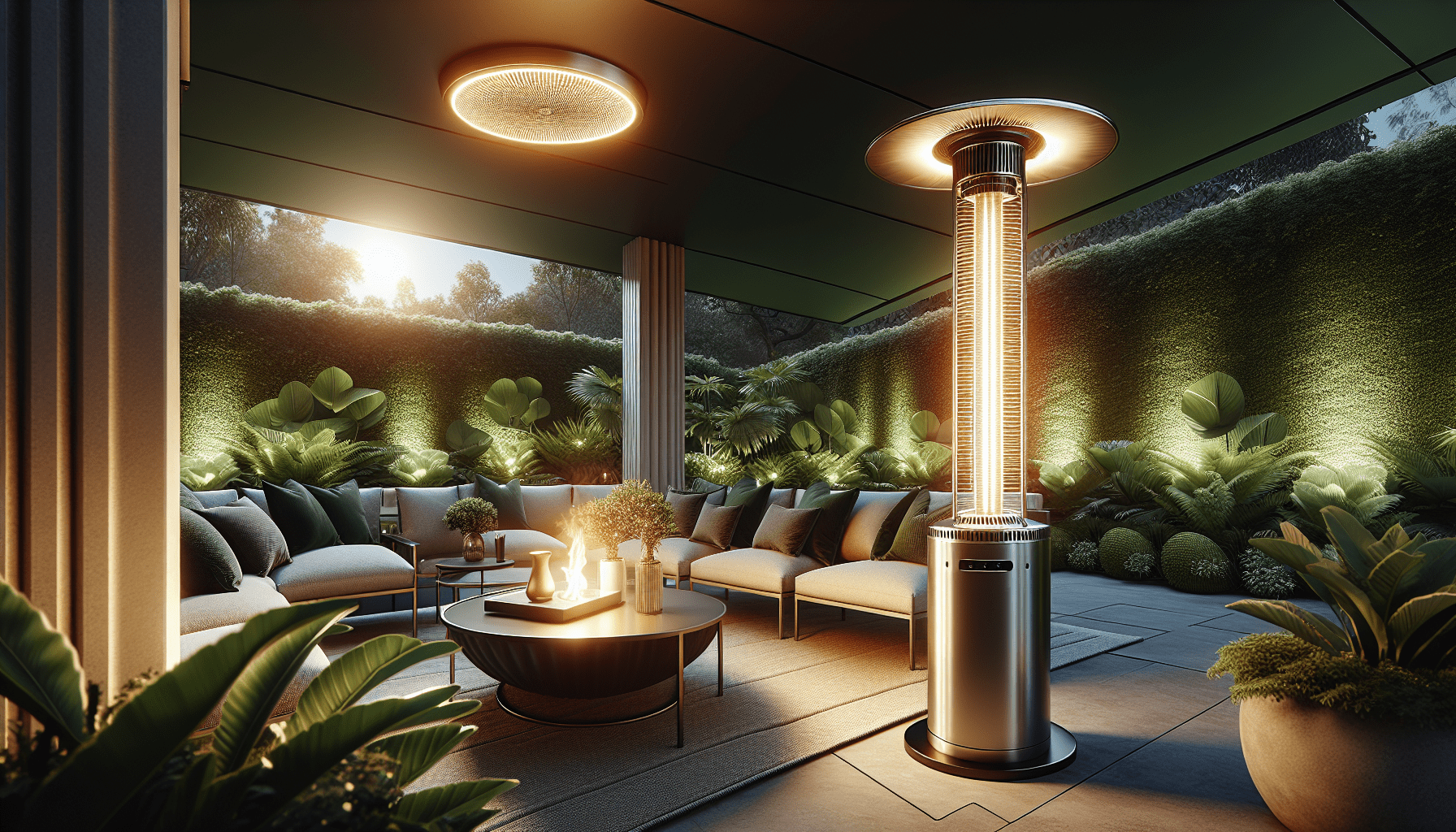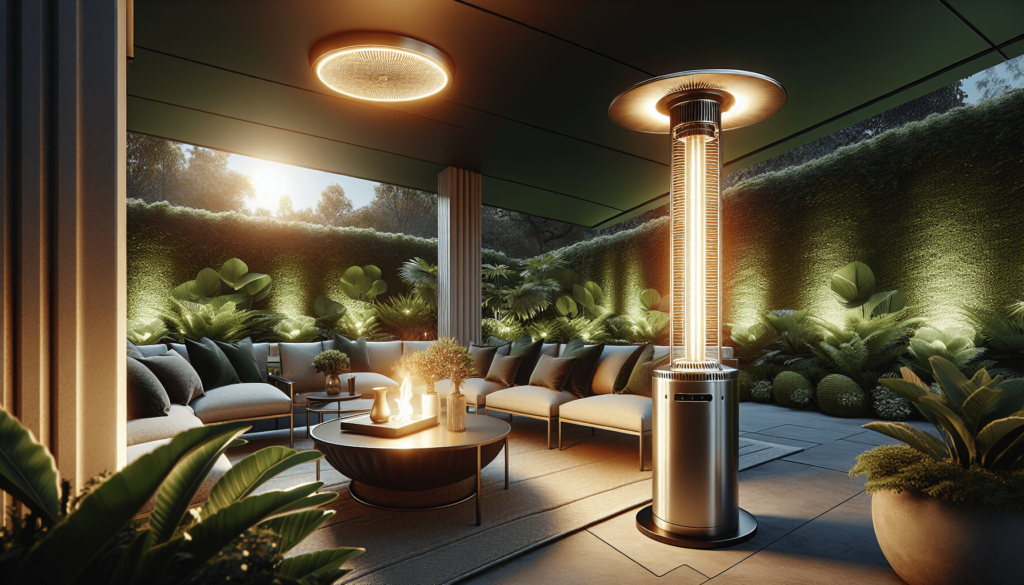
Have you ever considered how Patio Heaters could transform your outdoor space? Integrating warmth and aesthetics, patio heaters can become a focal point or seamlessly blend into your outdoor design. This guide delves into the aesthetics and functionality of patio heaters, providing you with the information you need to make an informed decision.

The Evolution of Patio Heaters
A Brief History
Patio Heaters have a rich history that dates back to the Chilly Pacífico sunset evenings in California during the late 1960s. The need for a comfortable, outdoor social life despite colder temperatures launched these devices into the forefront of home and restaurant design.
Current Trends
Today, patio heaters are not merely functional devices but art pieces and design elements that complement your outdoor aesthetics. From stainless steel to contemporary designs, brands like Bromic and Hampton Bay are redefining what it means to be both warm and stylish.
Types of Patio Heaters
Propane Patio Heaters
Among the most popular choices are propane patio heaters. They are portable, efficient, and often more powerful than their electric counterparts. Brands such as AZ Patio Heaters and Thermo Tiki offer units with safety features and multiple styles to suit any décor.
| Pros | Cons |
|---|---|
| High heat output | Requires propane tank |
| Portable | Refilling needed |
| Easy to install | Can be heavy |
Electric Patio Heaters
Electric patio heaters offer convenience and ease of use. Brands like Ener-G+ provide sleek designs with remote control capabilities, making them ideal for minimalist setups.
| Pros | Cons |
|---|---|
| No need for fuel | Limited heat output |
| Easy to operate | Requires electrical outlet |
| Often cheaper upfront | Not as portable |
Natural Gas Patio Heaters
For a permanent solution, natural gas patio heaters are a fantastic option. They provide consistent heat and are often integrated into the outdoor architecture. Brands like SunGlo and Fire Sense offer highly durable and stylish options.
| Pros | Cons |
|---|---|
| Cost-effective long-term | Professional installation needed |
| Consistent heat | Less portable |
| Environmentally friendly | Initial cost can be high |
Choosing the Right Design
Material Matters
The material of your patio heater can significantly influence its aesthetic and durability. Stainless steel tends to offer a modern look and is highly resistant to weather conditions. Powder-coated aluminum, on the other hand, can provide a broader range of color options while still being durable.
Design Elements
The design of your patio heater should blend seamlessly with your existing outdoor furniture and décor. For a rustic setup, consider models like the Hiland Pyramid Flame Heater, which adds an element of firelight and warmth. For a more contemporary design, the Bromic Platinum Smart-Heat series offers a sleek and minimalistic approach.
Matching with Outdoor Furniture
It’s essential to consider your existing outdoor furniture when choosing a patio heater. Choose shapes and colors that will complement your furniture rather than clash with it. For instance, if you have a predominantly wooden setup, a copper or bronze-colored heater might integrate nicely.
Safety First
Essential Safety Features
Safety should be a priority when selecting and using a patio heater. Look for features such as automatic shut-off, tip-over protection, and protective cover grates to ensure safe operation. Brands like Lava Heat Italia and Garden Treasures specifically focus on these safety elements.
Proper Placement
Consider where you’ll be placing your patio heater. It should be away from any flammable materials, including low-hanging branches or fabric canopies. Ensuring a safe distance from dining areas or walkways will help avoid accidental burns or trips.
Seasonal Maintenance
Regular maintenance can prolong the life of your patio heater while ensuring it operates safely. Clean the heating elements periodically, check for gas leaks, and store the heater appropriately during off-seasons. Manufacturers like Dyna-Glo offer detailed maintenance guides to assist you in this process.

Energy Efficiency
Comparing Fuel Types
One critical factor in choosing a patio heater is energy efficiency. Propane and natural gas heaters typically offer higher heat output and are cost-effective in the long run. However, electric heaters, while less intense, are easier to connect and can be more eco-friendly, depending on your power source.
| Fuel Type | Efficiency |
|---|---|
| Propane | High heat output, moderate cost |
| Natural Gas | Consistent supply, cost-effective |
| Electric | Lower output, eco-friendly |
BTU Ratings
BTUs (British Thermal Units) measure the amount of heat a heater produces. Understanding BTU ratings will help you choose a heater that meets your warmth requirements. For instance, residential models typically range around 5,000 to 50,000 BTUs.
| BTU Range | Coverage Area |
|---|---|
| 5,000 – 10,000 | Small patios (100-200 sq ft) |
| 10,000 – 30,000 | Medium patios (200-500 sq ft) |
| 30,000 – 50,000 | Large patios (500+ sq ft) |
Installation Considerations
DIY vs. Professional Installation
While some patio heaters, like most propane and electric models, can be easily installed by yourself, others, particularly natural gas heaters, might require professional help. Always follow manufacturer instructions and local regulations when installing your patio heater.
Ventilation
Proper ventilation is crucial, especially for propane and natural gas heaters. Ensure your outdoor area has sufficient airflow to disperse any fumes safely. Ventilation considerations are less critical for electric heaters, providing more flexibility in placement.
Mounting Options
Many modern patio heaters come with flexible mounting options, including wall-mounted, ceiling-mounted, and standing models. Brands like Bromic offer elegant ceiling-mounted heaters that help to free up floor space while providing targeted warmth.
Enhancing Aesthetic Appeal
Lighting Integration
Incorporating lighting elements into your patio heater can add an extra flair to your outdoor ambiance. Some models come with integrated LED lights for dual functionality. Consider heaters from Bromic that offer both heating and ambient lighting.
Decorative Screens
Decorative safety screens not only protect from accidental contact but also add a distinct decorative touch to your heater. Brands like e-Joy offer customizable screens that can make your heater both safer and more visually appealing.
Color Coordination
Many patio heaters are available in various colors and finishes. Choosing colors that match or complement your outdoor fixtures can greatly enhance the overall aesthetic. For example, a matte black heater may perfectly match a modern, industrial-themed patio.
Practical Functionality
Adjustable Heat Settings
Most high-quality patio heaters offer adjustable heat settings, allowing you to control the temperature to your liking. Brands like Bromic and AZ Patio Heaters offer models with multiple heat settings, ensuring optimal comfort.
Remote Control
Remote control functionality is a convenient feature that allows you to adjust settings without leaving your seat. Electric heaters like those from Ener-G+ come with this feature, adding an element of luxury and ease.
Weather Resistance
Since your patio heater will be exposed to the elements, selecting a weather-resistant model is crucial. Stainless steel and powder-coated models are highly resistant to rust and corrosion. For added durability, look for heaters with IP ratings that indicate water and dust resistance.
Cost Considerations
Initial Investment
The initial cost of patio heaters can vary significantly based on type, brand, and additional features. While propane heaters such as those from Hiland can be affordable, more sophisticated models like the Bromic Tungsten Smart-Heat can be a substantial investment.
Operational Costs
When considering the operational cost, factor in fuel refills for propane heaters or electricity consumption for electric models. Natural gas heaters often have the lowest operational cost but may require a higher initial investment due to installation fees.
| Heater Type | Initial Cost | Operational Cost |
|---|---|---|
| Propane | Moderate | Medium-high |
| Electric | Low-moderate | Medium |
| Natural Gas | High | Low |
Longevity and Warranty
Investing in a high-quality patio heater can offer better longevity and a more extended warranty. Brands like Fire Sense and SunGlo typically provide robust warranties, ensuring peace of mind and long-term savings.
Bringing it All Together: Aesthetic Warmth
Creating a Cohesive Design
Ultimately, the goal is to create a cohesive and inviting outdoor space. By carefully selecting a patio heater that complements your furniture and follows the design elements of your space, you can ensure both functionality and aesthetic appeal.
Personal Touch
Adding personalized touches, such as decorative screens, customized colors, and integrated lighting, can make your patio heater a statement piece rather than just a functional addition.
Seasonal Adaptability
Consider how your patio heater can adapt to various seasons. Some models come with settings that allow them to be useful during both cooler and warmer months, providing year-round utility.
Conclusion
Designing with heat involves more than just choosing a device to keep you warm; it’s about integrating an element that enhances your outdoor living space’s overall aesthetics and functionality. By considering the different types of patio heaters, their design options, and practical features, you can make an informed decision that will not only warm your evenings but also elevate the beauty of your patio. So go ahead and find the perfect patio heater that speaks to your style and meets your practical needs, ensuring countless cozy moments and outdoor enjoyment.




